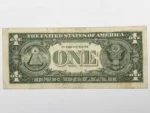Introduction to the 1985 Boston $1 Note
The 1985 Boston $1 note stands as a remarkable piece within the broader spectrum of U.S. currency, particularly due to its unique serial number. Issued as part of the Federal Reserve Note system, this note is a testament to the intricate processes and regional contributions that shape the nation’s monetary framework. Each Federal Reserve Note is a legal tender issued by one of the twelve Federal Reserve Banks, with the Boston Federal Reserve Bank being denoted by the letter ‘A’ and the numeral ‘1’ on the note.
Established in 1914 as part of the Federal Reserve Act, the Federal Reserve System serves as the central banking system of the United States. Its primary objectives are to regulate monetary policy, supervise and regulate banks, maintain financial stability, and provide banking services. The Boston Federal Reserve Bank, one of the twelve regional banks, plays a critical role in these functions, particularly in the New England region.
The 1985 series saw significant circulation, yet certain notes, like the one with the serial number 33333333, have captured the attention of collectors and numismatists. Serial numbers on currency are more than mere identifiers; they can represent rarity and therefore, value. A note bearing a unique or repeating sequence, such as the 1985 Boston $1 note, is considered especially rare and highly sought after. These characteristics transform an otherwise common piece of currency into a prized collector’s item.
Understanding the significance of the 1985 Boston $1 note requires an appreciation of both its historical context and its issuance under the Boston Federal Reserve Bank. This note not only reflects the operational intricacies of the Federal Reserve but also underscores the allure of unique serial numbers in the world of currency collection. Collectors often seek out such distinctive notes, recognizing them as an intersection of historical importance and numismatic rarity.
Understanding Solid 3 Fancy Serial Number 33333333
Fancy serial numbers are a fascinating niche within the world of currency collecting, often driving significant interest and value to specific notes. These unique serial numbers are characterized by their patterns, repetitions, or sequences, making them stand out from ordinary currency. Collectors highly prize fancy serial numbers for their rarity and aesthetic appeal, which can considerably enhance a note’s desirability and market value.
Among the various types of fancy serial numbers, repeating digits hold a special place. Repeating digits, such as 11111111, 22222222, or in this case, 33333333, are particularly sought after due to their symmetrical and visually striking nature. The serial number 33333333 is an exemplary instance of a repeating digit sequence, where all eight digits are identical. This rarity significantly escalates its value among collectors, who often see it as a remarkable find.
The allure of the serial number 33333333 lies not just in its visual symmetry but also in its statistical improbability. The chances of encountering such a perfectly repeated sequence are exceedingly low, making each discovery a noteworthy event. This rarity is compounded when the number appears on a note from a historically significant series, such as the 1985 Boston $1 note, further amplifying its appeal and value.
Collectors often categorize fancy serial numbers into various types, including low serial numbers (e.g., 00000001), high serial numbers (e.g., 99999999), and palindromic or radar numbers (e.g., 1234321). Among these, repeating digit sequences like 33333333 are distinctly memorable and often command a premium in the collectors’ market.
In conclusion, fancy serial numbers add a layer of intrigue and value to currency collecting. The specific case of the 1985 Boston $1 note with the serial number 33333333 exemplifies the allure and rarity that make such notes highly coveted among enthusiasts. This fascination underscores the broader appeal of numismatics, where the hunt for unique and rare pieces offers both financial and sentimental rewards.
The Rarity of the 1985 $1 Note with Serial Number 33333333
The 1985 $1 note with the serial number 33333333 stands out as a significant rarity in the realm of numismatics. The unique sequence of identical digits creates a visually striking and highly sought-after serial number, enhancing its desirability among collectors. One of the primary factors contributing to its scarcity is the statistical improbability of such a serial number appearing in circulation. Given the vast number of $1 notes printed annually, the odds of encountering a note with all identical digits are exceedingly low.
Print runs play a critical role in determining the rarity of specific serial numbers. During the production of currency, serial numbers are assigned sequentially, which means that for every 10 million notes printed, only one will bear the serial number 33333333. The sheer volume of notes produced in a given year dilutes the chances of this unique serial number emerging. Furthermore, not all notes printed in a series are released into circulation, further diminishing the likelihood of discovering such a note.
Survival rates also factor into the rarity equation. Currency notes, especially lower denominations like the $1 bill, experience significant wear and tear due to frequent handling. Over time, many notes are withdrawn from circulation due to damage or deterioration. Consequently, the number of 1985 $1 notes surviving in pristine condition is already limited. The survival rate of a note with such a distinctive serial number, therefore, is even lower, making it a precious find for collectors.
The combination of these factors—statistical rarity, print run limitations, and survival rates—culminates in the exceptional scarcity of the 1985 $1 note with the serial number 33333333. Its unique characteristics and the improbability of its existence make it a prized possession, further enhancing its allure and value within the numismatic community.
Historical Context: The 1985 Series
The 1985 series $1 notes emerged during a period marked by significant economic and financial developments in the United States. The mid-1980s were characterized by recovery from the early decade’s recession, with the economy experiencing steady growth and declining inflation rates. This economic stability prompted an increased demand for currency, which necessitated the production of new series of banknotes, including the 1985 $1 note.
One of the notable changes in the design of the 1985 series was the introduction of advanced printing techniques. These innovations aimed to enhance the security features of the currency and minimize the risk of counterfeiting. Although the $1 note maintained its traditional appearance featuring the portrait of George Washington on the obverse and the Great Seal of the United States on the reverse, subtle enhancements in the printing process were implemented to ensure durability and clarity.
Additionally, the Bureau of Engraving and Printing (BEP) during this period made strides in improving the production efficiency of banknotes. This was a time when the BEP was transitioning from older printing presses to more modern, high-speed presses, which allowed for increased output and improved quality control. These advancements contributed to the overall collectibility of the 1985 series, as collectors often seek notes that reflect pivotal changes in currency production.
The economic conditions and technological advancements of the 1985 era significantly impact the collectibility of the $1 notes from this series. Collectors value these notes not only for their historical significance but also for their representation of a transformative period in U.S. currency production. The rarity of unique serial numbers, such as the 33333333 sequence, further enhances their desirability among numismatists. The intersection of historical context, production innovations, and economic conditions makes the 1985 $1 note a fascinating subject for both collectors and historians alike.
The Collectibility and Value of Fancy Serial Number Notes
In the realm of numismatics, fancy serial number notes hold a significant allure for collectors. These notes, distinguished by their unique numerical sequences, often command a higher value compared to their standard counterparts. The 1985 Boston $1 note with the serial number 33333333 is a prime example of such a collectible. The valuation of these notes depends on several key factors, including condition, demand, and recent auction results.
The condition of a fancy serial number note is paramount in determining its value. Notes that are crisp, uncirculated, and free from any imperfections typically fetch higher prices. Grading systems, such as those used by the Professional Coin Grading Service (PCGS) or the Paper Money Guaranty (PMG), provide a standardized method to assess the quality of these notes. A note graded as “Gem Uncirculated” can significantly increase its market value.
Demand also plays a crucial role in the valuation of fancy serial number notes. Certain sequences, such as solid numbers (e.g., 33333333), radar notes (e.g., 12344321), or ladder notes (e.g., 12345678), are particularly sought after by collectors. The rarity and aesthetic appeal of these patterns can drive up their desirability and, consequently, their market price. Collectors often seek out these unique sequences for their visual symmetry and novelty.
Recent auction results provide a tangible gauge of the market value for fancy serial number notes. Historical data from auctions reveal trends and fluctuations in prices based on the aforementioned factors. For instance, notes similar to the 1985 Boston $1 with serial number 33333333 have been known to sell for several hundred to thousands of dollars, depending on their grade and demand at the time of sale. These auction results offer valuable insights for both seasoned and novice collectors in estimating the worth of their notes.
In conclusion, the collectibility and value of fancy serial number notes are influenced by a combination of their condition, market demand, and auction performance. The 1985 Boston $1 note with serial number 33333333 exemplifies the allure and potential worth of these unique collectibles within the numismatic community.
Proper preservation and care are paramount when it comes to maintaining the value and condition of rare currency, such as the 1985 Boston $1 note with the unique serial number 33333333. Handling, storage, and protection are key aspects that collectors must pay careful attention to in order to ensure these treasured items remain in pristine condition.
Handling Rare Currency
When handling rare currency, it is crucial to minimize direct contact with the note to prevent oils, dirt, and moisture from transferring to its surface. Wearing cotton gloves is highly recommended, as they provide a barrier between the skin and the note. If gloves are not available, ensure hands are thoroughly washed and dried before handling. Additionally, holding the note by its edges can further minimize the risk of damage.
Storage Solutions
Proper storage is essential for preserving the note’s quality. Store the note in a cool, dry environment with stable temperature and humidity levels to prevent deterioration. Avoid areas with direct sunlight, as UV rays can cause fading and discoloration over time. Utilizing acid-free, archival-quality currency holders or sleeves can provide an additional layer of protection against environmental factors. For added security, consider placing the note in a fireproof and waterproof safe.
Protection Measures
Maintaining the note’s condition also involves safeguarding it from potential physical damage. Avoid folding or creasing the note, as this can lead to permanent damage. When displaying the note, use a frame with UV-resistant glass to shield it from harmful light exposure. Regularly inspect the storage area and protective materials for signs of wear or damage, and replace them as needed to ensure ongoing protection.
By adhering to these best practices for handling, storage, and protection, collectors can preserve the integrity and value of their rare currency, ensuring it remains a treasured piece for years to come.
Case Studies: Notable Sales of Fancy Serial Number Notes
Fancy serial number notes have long held a special place in the hearts of collectors, often fetching remarkable prices at auctions and private sales. One of the most compelling aspects of these notes is their rarity and the unique numerical sequences that make them stand out. For instance, a notable sale occurred in 2014, when a 2003 $2 bill with the serial number 00000001 was auctioned for $2,500. This sale underscored the significant premium collectors are willing to pay for such unique pieces.
Another exemplary case is the sale of a 1977 $100 bill with the serial number 88888888, which was sold in a private transaction for an astounding $10,000. The number 8 holds particular cultural significance in certain communities, often symbolizing prosperity and good fortune, further driving up its desirability and value. This sale not only highlighted the importance of numerical patterns but also the cultural factors that can influence a note’s worth.
Public auctions have also seen impressive results. In 2018, a 1995 $1 bill with the serial number 12345678 was sold at a prominent auction house for $7,500. This sequential serial number is incredibly rare, making it highly sought after by collectors. The auction generated significant interest, demonstrating the strong market demand for fancy serial number notes.
In addition to auctions, private sales have also revealed the high valuation potential of these notes. A 1988 $50 bill featuring the serial number 77777777 was privately sold for $8,000. The repetition of the number 7, another culturally significant digit, contributed to its valuation, proving that both numerical uniqueness and cultural significance play crucial roles in determining a note’s market value.
These case studies provide a comparative analysis that gives collectors and enthusiasts an idea of the potential valuation of fancy serial number notes. Each sale underscores the rarity, cultural significance, and numerical uniqueness that make these notes highly prized possessions in the world of numismatics.
Conclusion: The Allure of the 1985 Boston $1 Note with Serial Number 33333333
The 1985 Boston $1 note with the serial number 33333333 stands as a significant piece in the world of currency collecting. Its rarity and unique serial number make it a highly sought-after item among collectors. Throughout this blog post, we have explored the historical context, the significance of serial numbers in currency, and the specific appeal of this particular note. The limited availability and distinctive features of this note contribute to its desirability, making it a prized possession for any serious collector.
One cannot overlook the historical and monetary value that such rare finds hold. The 1985 Boston $1 note represents not just a piece of currency, but a snapshot of a particular era in the United States’ financial history. Its pristine condition and the unique serial number amplify its worth, offering a tangible connection to the past and a potential investment for the future. This note is more than just paper money; it is a blend of artistry, history, and rarity that ignites the passion of currency enthusiasts.
For those new to currency collecting, the 1985 Boston $1 note with the serial number 33333333 serves as an intriguing introduction to the hobby. It exemplifies the excitement of discovering rare and valuable pieces that hold both historical and financial significance. Collectors and historians alike can appreciate the intricate details and the stories embedded within such notes. As you delve deeper into the world of currency collecting, let this remarkable note inspire you to uncover other hidden treasures and appreciate the rich tapestry of history they represent.
In conclusion, the allure of the 1985 Boston $1 note with the serial number 33333333 lies in its rarity, historical value, and the unique charm it brings to any collection. Whether you are a seasoned collector or a novice enthusiast, this note is a testament to the captivating world of currency collecting, encouraging exploration and appreciation of the fascinating stories behind each piece.
























Martin (verified owner) –
As a collector, I’m impressed with their selection. They have everything from rare bills to more common ones, catering to all types of enthusiasts.
Zaiden (verified owner) –
I’ve purchased from several online currency sites, and this one stands out for its authenticity and fair pricing.